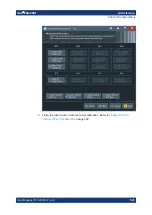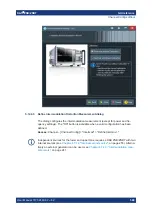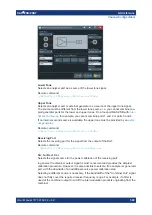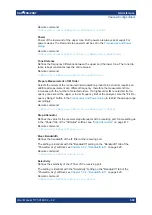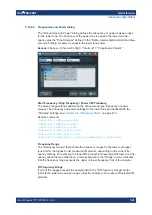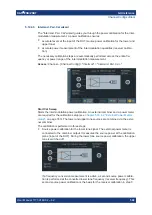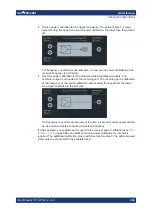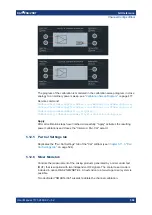
GUI reference
R&S
®
ZNB/ZNBT
579
User Manual 1173.9163.02 ─ 62
Consider the following test setup with a strongly reflecting DUT (e.g. a bandpass in its
stop band) that is measured in transmission. The incident wave
a
1
is generated at a
frequency RF. The reflected wave
b
1
falls into the receiver mixer of the analyzer port 1;
a small fraction of the mixer product RF + 2*IF can be reflected back towards the DUT.
If this spurious wave
a'
1
passes the DUT, then it is received as
b'
2
at port 2, together
with the wanted signal
b
2
.
LO > RF implies that LO = RF + IF. The mixer at port 2 converts both the wanted signal
b
2
and the spurious signal
b'
2
which is at the frequency RF' = IF + LO, to the same IF
frequency. The response of an ideal, infinitely steep bandpass filter with a pass band
between B
-
and B
+
looks as follows:
For a wide bandpass, the spurious response flattens the filter edges.
The spurious signal can be eliminated by dividing the sweep range into two segments
with different LO settings:
●
In the low-frequency segment ranging up to the center frequency of the bandpass
filter, the frequency of the local oscillator is set to LO < RF. This setting ensures
that the spurious signal b'
2
is not measured at port 2.
●
In the high-frequency segment, starting at the center frequency of the bandpass fil-
ter, the frequency of the local oscillator is set to LO > RF. If the center frequency is
larger than B
+
– 2*IF, then there is no distortion from b'
2
.
Remote command:
LO Suppression
A small portion of the local oscillator (LO), which drives the mixer of the receivers, can
leak out of the test ports of the R&S
ZNB/ZNBT. This can lead to compression of high
gain DUTs.
The function LO suppression lowers the LO power of all receivers and thus the power
leaking out of the test ports.
Channel Config softtool























